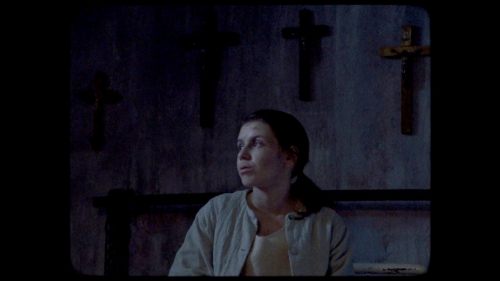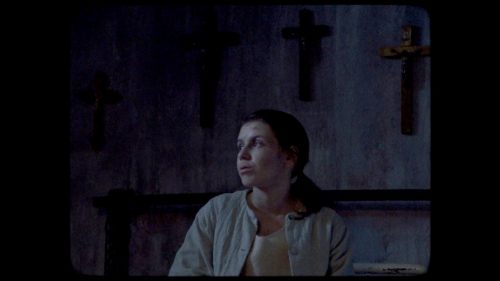THE DEVIL’S DOORWAY Review: Raising A Tired Occult Genre From Perdition
“The evil I’ve seen has always been the human kind. There’s no evil in this world or the next that can surpass that done by a human hand. That goes for the miracles, as well. All of the miracles I’ve seen…can be explained by the trickster, fraud, just some priest. But we don’t want to believe that, do we?” - Father Riley
The now-infamous Magdalene laundries remain a dark mark upon Irish history. Functioning as religiously-run labor camps for women (with the public image of “treating repentant women”), the asylums were host to countless abuses throughout the 19th and 20th centuries, from involuntary committals and medical procedures to abysmal workplace conditions to the later discovery of mass, unmarked graves of women. It’s within this frame of reference that Aislinn Clarke makes subtext into text in her feature-length debut film, The Devil’s Doorway.
In 1960, two priests— Father Thomas Riley (Lalor Roddy) and Father John Thornton (Ciaran Flynn)— are summoned by the Catholic Church to investigate reports of a miracle at a women’s Catholic asylum for domestic violence victims, prostitutes, unwed mothers, and the mentally disabled. An anonymous letter claims that not only is the convent’s Virgin Mary statue weeping blood, but the higher-echelon nuns are attempting to cover it up. 16mm film cameras in tow, the priests arrive on the scene to take samples, interview witnesses, and record it all. As the investigation continues, the priests uncover a multitude of horrors involving the nuns, the “fallen women”, and something ungodly.
The trope of the older, seasoned priest and the greenhorn younger priest finds gainful employment in The Devil’s Doorway. Father Thornton is recently graduated from seminary, wide-eyed and excited at the prospect of being the first to capture a miracle on film. Father Riley, on the other hand, is not quite a lapsed Catholic, but he has been around the block and understands that the investigation process is a long and often fruitless one. As with so many supernatural films in this vein, the priests’ struggle with their faith takes a central role over that of the brutalized bodies of the victims they are attempting to help. But here, the tired narrative trope is given an unsettling breath of fresh air with its infusion of historical context, and the priests’ secondary struggle with the potential sin of bearing witness to atrocities and not acting upon it. The men approach their faiths from polar endpoints: Thornton is ready to believe that the Virgin Mary statue could be miraculously weeping, while Riley sets out with a conclusion already formulated, that there is a logical explanation for whatever is going on. And so the men look for either phenomenon or trickery, whatever that may be.
Soon the priests discover that a pregnant girl, Kathleen O’Brian (Lauren Coe), is being kept shackled in the basement of the institution because, the Reverend Mother claims, she is a danger to herself and others. That danger takes on a new dimension of terror when the girl begins speaking in a language she couldn’t possibly know and displays other signs of demonic possession. A medical examination unearths a seemingly immaculate conception; the girl is “intact.”
The sight of Kathleen filthy and chained up in a cold room upsets both priests deeply, and they soundly condemn the Reverend Mother for allowing this and other inhumane treatment to happen on her watch. Helena Bereen stands out among the capable cast in her cold Nurse Ratched-like austerity and complete self-righteousness in every action and reaction. It is she that points out to the priests that the women’s asylum is the place for the sins of the country, and of the Catholic Church, to be washed away. “Do y’know how many of the Church’s messes that I’ve personally had to clean up? Do y’know how many of the babies born here had fathers who were Fathers, Father?”
The Devil’s Doorway is hardly the first found-footage possession film to utilize the exorcism itself to unleash a deep, dark secret regarding the occupied vessel. Both Apartment 143 and The Last Exorcism carried that cross. What sets The Devil’s Doorway apart is its indictment of systematic Church atrocities of the sins of a nation’s past coming back to torment them, personified in the violated body of an innocent girl and her unborn, unwanted child. Sure, it gets tiresome to see the crosses flip upside down and the body contortion, right on cue. But the grand socio-political designs embroidered into these cinematic banalities makes their usage ultimately forgivable and interesting.
Speaking of babies, there are supposedly no children present in the building, and haven’t been in decades. But at night, children’s laughter and the cries of babies can clearly be heard on Father Thornton’s footage, as well as glimpses here and there of children and toys. Again, it’s an exhausted device within supernatural films, but Clarke applies it with a purpose and meaning highly relevant to the historical injustice that it alludes to.
Outside of the stale storytelling elements, Clarke’s sense of craft is unmistakable. Several moments in the film find little to look at but plenty to listen to, putting the audience in the confessor’s seat. One scene depicts nothing visually but a tight, stationary shot of a tape reel in play, as the voices of Fathers Thornton and Riley converse over bootlegged music. Specifically, they’re listening to the Mass that the inmates sang at a WWII-era concentration camp. Amid the pop and hiss of the reel, Thornton reveals himself to find beauty not in the music itself but in its challenging existence— women weren’t allowed to sing mass, but the Pope granted a special dispensation for these extreme circumstances. Another sequence has audio of a nun confessing to sending the anonymous letter that brought the priests out, juxtaposed with images of the nuns submitting themselves to blood tests to rule out the possibility of pregnancy. Clarke’s emphasis on audio over imagery in these moments feels unorthodox, but reveals a profound humanity in both the protagonists’ outlooks and the stark fear present in those who inhabit the convent. Layered with the grainy textures of the 16mm film stock and the period-accurate frame cropping, Clarke’s commitment to the bit shines while pushing durable genre techniques to their limits.
These days, both found footage and paranormal films are as readily available and recklessly churned out as the zombie movie. But The Devil’s Doorway deploys the tropes with enough intent to make an impact that surmounts the crop of their respective genres.


